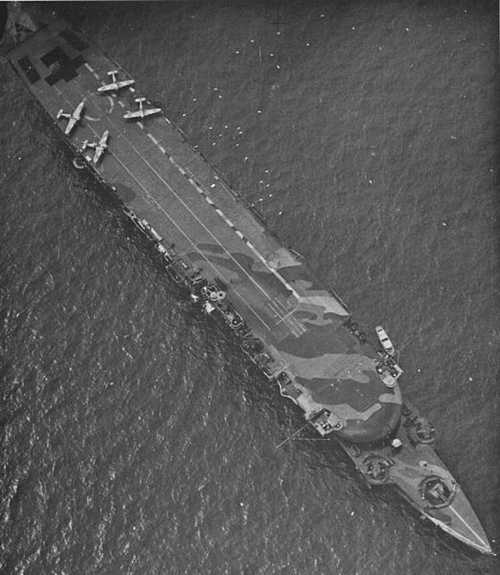
British Forces
A very important ship - HMS Furious.
H.M. Government.
HMS Furious from the air, 1941. At this stage, "Furious" was a humble transport carrier, carrying replacement aircraft for front line carriers such as HMS Ark Royal, and for ground bases in the Med. Four Hurricanes can be seen on the deck, replacements, no doubt, for an unidentified destination. This humble function conceals the huge historical significance of this vessel. Laid down as a "Courageous Class" battle cruiser during WW1, "Furious" actually became the long-term test-bed for the new class of capital ship, the aircraft carrier. The original inspiration for this came from Royal Navy C-in-C Admiral "Jackie" Fisher, founder of the RN Fleet Air Arm, who perceived that an effective means of transporting air power over water - superior to the early seaplanes and flying boats - was needed to help deal with the WW1 U-boat menace to the UK. Building on experience from limited experience of trials launching single Sopwith Camel and Pup fighters off improvised flight ramps installed on cruisers and destroyers, "Furious" was modified in the course of construction to accommodate aircraft hangars and elevators, and the development of a flight deck through the removal of much of the ship's superstructure. By March, 1918, after much hair-raising trial and error, a reasonably effective procedure for launching Sopwith fighters off the flight deck had been devised. Experiments continued in the postwar period, involving, mainly, the extension of the flight deck through the removal of most of the original cruiser superstructure. In WW2, "Furious" served first as a transatlantic escort carrier, then in a combat role in the Norway campaign. It subsequently served as a transport carrier in the Med. and in British home waters. By this stage, it was certainly obsolete in relation to its "childeren", the more modern carriers. It was finally decommissioned in 1954. Far from its original intended purpose, HMS Furious ended up as the predecessor and ancestor of all subsequent British, American and (through industrial espionage) Japanese aircraft carriers; and her legacy continues in carrier technology down to the present day. Best regards, JR.
3156 Views
12/10/2012
